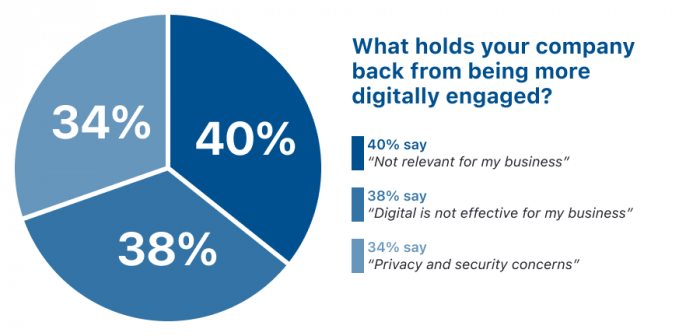I’m talking about the kind of fear that prevents businesses from making technology decisions.
If you suffer from this fear, you are not alone. But don’t worry, there’s a lifeline within reach.
Facing too many options
Remember your first catalog of classes when you were a freshman? Choosing was hard! When you have a lot of options it’s more difficult to make a decision.
Taking the wrong course in college can prove to be a temporary setback. Choosing the wrong technology can have long-term consequences for a business on a tight budget.
When considering technology upgrades, there are a lot of options. Publications and consultants such as Capterra and The Balance Small Business name the following as trending or recommended for small businesses:
- Chatbots
- AI and machine learning
- Cloud computing
- 3D printing
- Time tracking software
- Project management and task management tools
- Online invoicing
- Team messaging
- Online surveys for customer feedback
And that’s just a partial list. With so many options, no wonder many business operators are afraid to make technology decisions.
But having too many options isn’t the only cause of technophobia.
Operating in a digital leadership vacuum
In Connecting Small Businesses in the US, Deloitte reported that small businesses with high levels of digital engagement fare better than those with low levels of digital engagement. Those companies enjoyed:
- Twice as much revenue earned per employee
- Four times higher year-to-year revenue growth
- Nearly three times as likely to be adding jobs over the previous year
But those businesses with high levels of digital engagement represented a small minority.
Deloitte followed-up by asking a further 2,000 small businesses why the majority of U.S. small businesses (80%) “are not fully realizing their digital potential.”
When asked which barriers held the company back from being more digitally engaged, respondents selected these three options most.
Do these responses seem defensive and out of touch?
Deloitte concluded that less digitally engaged small businesses might not know of the benefits that using digital tools can generate. That’s one way of saying that these organizations have no one at the top leading their digital efforts.
In some cases, the company may be slowed by an executive team that doesn’t have the time or inclination to stay current with technology. They stay in their lane.
The company may be slowed by an executive team that doesn’t have the time or inclination to stay current with technology. They stay in their lane.
Many small businesses employ a small IT staff and/or a managed service provider to make sure their technology works as intended. In these arrangements, the job of IT is to keep the company running.
That is not the same as having forward-thinking leadership that is responsible for formulating a digital strategy. And a strategy is what’s needed to overcome stagnation and fear of technology.
Your Technology Strategy Lifeline
The TV game show Who Wants to Be A Millionaire gave contestants a chance to win a million dollars.
Contestants had to provide the correct answers to a series of questions. To help them, the show gave contestants a lifeline (calling a friend or family member by phone) if they were unsure of their answer.
The key, of course, was to call someone who would know the answer.
Businesses need more than one person to build a technology strategy, so their lifeline involves more than one call. But the key to the lifeline is the same: call the right people.
By following these tips, you will build your lifeline and eliminate fears that the decisions you make could harm the business.
1. Enlist your employees to research the technology steps taken by other companies in your vertical. These are the people who will use the technology.
2. Survey managers about what type of technology they would like to see implemented. These recommendations will inform the discussion and get managers involved.

4. If you have an advisory board, add someone who can provide helpful feedback to the virtual CIO’s recommendations.
Bring on a virtual CIO. A good virtual CIO evaluates the technologies the business should be using now and in the future. They also recommend an affordable path to acquiring and implementing those technologies.
Stay Ahead of the Competition
It’s not easy to keep up with technology, but it is vital to keep up with (or ahead of) the competition.
When you put together a team to develop and implement a technology strategy, there will be costs. But the rewards derived from technologies that help a company compete and grow require businesses to step up — even small businesses.
The least effective thing any business can do today is to allow its fear of technology keep it running in place as the competition races by.







